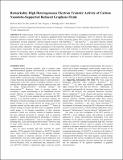| dc.contributor.author | Mao, Xianwen | |
| dc.contributor.author | Guo, Fei | |
| dc.contributor.author | Yanow, Esther | |
| dc.contributor.author | Rutledge, Gregory C | |
| dc.contributor.author | Hatton, Trevor Alan | |
| dc.date.accessioned | 2017-09-27T17:30:21Z | |
| dc.date.available | 2017-09-27T17:30:21Z | |
| dc.date.issued | 2016-10 | |
| dc.date.submitted | 2016-07 | |
| dc.identifier.issn | 0897-4756 | |
| dc.identifier.issn | 1520-5002 | |
| dc.identifier.uri | http://hdl.handle.net/1721.1/111648 | |
| dc.description.abstract | Enhancement of the heterogeneous electron transfer (HET) activities of graphene materials toward redox-active molecules assumes a crucial role in numerous graphene-based electrochemical technologies. Here we discover that carbon-nanotube-supported reduced graphene oxide (rGO/CNT) exhibits unusually higher HET activities (including electrocatalytic performance toward dopamine, electron transfer kinetics with Ru(NH₃)₆[superscript 3+/2+] and Fe(CN)₆[superscript 3–/4–], and direct electron transfer efficiencies with cytochrome c and horseradish peroxidase) than does CNT-free rGO with an identical electrochemical surface area and surface chemistry. Through examination of the electronic structure combined with Gerischer–Marcus calculations, the critical factors responsible for this anomalous enhancement of the HET activities in rGO/CNT are identified to be a high density of π electronic states, up-shifting of the Fermi level, and appearance of a pronounced quantum-capacitance-dominating character. These results indicate a general strategy to improve the HET properties of graphene by using a π-electron-rich substrate to modulate electronic structure, and provide insight into the importance of the quantum capacitance in graphene electrochemistry. | en_US |
| dc.language.iso | en_US | |
| dc.publisher | American Chemical Society (ACS) | en_US |
| dc.relation.isversionof | http://dx.doi.org/10.1021/acs.chemmater.6b03024 | en_US |
| dc.rights | Article is made available in accordance with the publisher's policy and may be subject to US copyright law. Please refer to the publisher's site for terms of use. | en_US |
| dc.source | Prof. Rutledge via Erja Kajosalo | en_US |
| dc.title | Remarkably High Heterogeneous Electron Transfer Activity of Carbon-Nanotube-Supported Reduced Graphene Oxide | en_US |
| dc.type | Article | en_US |
| dc.identifier.citation | Mao, Xianwen et al. “Remarkably High Heterogeneous Electron Transfer Activity of Carbon-Nanotube-Supported Reduced Graphene Oxide.” Chemistry of Materials 28, 20 (October 2016): 7422–7432 © 2016 American Chemical Society | en_US |
| dc.contributor.department | Massachusetts Institute of Technology. Department of Chemical Engineering | en_US |
| dc.contributor.approver | Rutledge, Gregory C. | en_US |
| dc.contributor.mitauthor | Mao, Xianwen | |
| dc.contributor.mitauthor | Guo, Fei | |
| dc.contributor.mitauthor | Yanow, Esther | |
| dc.contributor.mitauthor | Rutledge, Gregory C | |
| dc.contributor.mitauthor | Hatton, Trevor Alan | |
| dc.relation.journal | Chemistry of Materials | en_US |
| dc.eprint.version | Author's final manuscript | en_US |
| dc.type.uri | http://purl.org/eprint/type/JournalArticle | en_US |
| eprint.status | http://purl.org/eprint/status/PeerReviewed | en_US |
| dspace.orderedauthors | Mao, Xianwen; Guo, Fei; Yan, Esther H.; Rutledge, Gregory C.; Hatton, T. Alan | en_US |
| dspace.embargo.terms | N | en_US |
| dc.identifier.orcid | https://orcid.org/0000-0003-0879-6018 | |
| dc.identifier.orcid | https://orcid.org/0000-0001-8137-1732 | |
| dc.identifier.orcid | https://orcid.org/0000-0002-4558-245X | |
| mit.license | PUBLISHER_POLICY | en_US |
